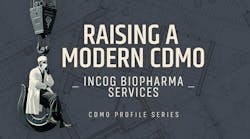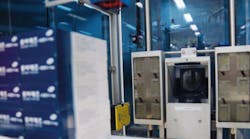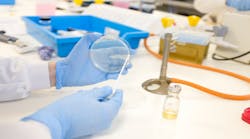Chinas pharmaceutical sector has maintained steady growth over the past few years (see Figure 1). [1] Recent statistics showed that total revenue for the Chinese pharmaceutical industry reached $54.6 billion (437.3 billion RMB) in 2005, a 25.8% increase over 2004. [2] The industrys prosperity has given birth to domestic outsourcing segments, such as contract manufacturing and contract research. Expansion of Contract Research Organizations (CROs) is in turn fueling the growth of Chinas pharmaceutical industry and enhancing opportunities for international collaboration.
Dennis Gillings, CEO of Quintiles Transnational, acknowledged the growth of China's domestic pharmaceutical market at the Boao Forum for Asias World Pharmaceutical Industry Conference in Taizhou. "China...today accounts for a small part of the value of the pharmaceutical and biotechnology industries relative to their huge population, he said. [They] will grow their share of pharmaceutical market value many times by 2030... CROs can help pharmaceutical companies develop drugs for marketing approval in China.
Contract manufacturing was one of the first growth areas in Chinese pharmaceuticals. Since the early 1990s, an increasing number of Chinese Contract Manufacturing Organizations (CMOs) have engaged in Active Pharmaceutical Ingredient (API) production, and many are endeavoring to meet international production standards for finished drugs. In 2004, Chinese CMOs generated RMB 60 billion (US $7.5 billion) domestic output, [3] which accounted for 13% of the countrys gross pharmaceutical outputnot an insignificant figure considering contract manufacturing is still young in China. According to statistics released by China Customs, Chinas API export value achieved US $7.9 billion in 2005, a 27.6% increase over 2004. This was attributed primarily to the outsourcing businesses associated with some large API CMOs, including Zhejiang Hisun, Suzhou Lederle, Shandong Xinhua Pharma and Shandong Meiji Lukang Pharma.
Quickly following the expansion of CMOs, CROs first emerged in China in the mid-1990s, when several of the worlds leading CROs established a presence in Beijing. Contract research has experienced explosive growth since then, and today China is home to more than 300 CROs of all sizes. [4] This growth has been fueled by demographic changes and economic trends, as well as recognition of the opportunities associated with a market whose potential has been estimated at up to 8 billion RMB (US$1 billion). The future of this industry and the problems associated with such rapid growth are now being addressed by the Chinese government, the industry and trade associations.
China is becoming a hot location for global outsourcing of pharmaceutical projects, observed Xiaoming Zhou, president of the China Chamber of Commerce of Medicines & Health Products Exports & Imports. Addressing the Boao Pharmaceutical Forum in Taizhou recently, he said, China has an edge in low labor costs raw materials and energies, and [our] facilities are very competitive. In addition, China has a strong team of high-caliber research professionals. [5]
Emergence of CROs in China
Contract research originated in the U.S. in the 1980s and quickly became popular throughout the world. Presently, CROs are playing an indispensable part in global biotech and pharmaceutical initiatives. Recent surveys suggest global CRO revenues reached $16.3 billion in 2005, up 14% from $14.3 billion in 2004. The U.S. and Europe comprise 88% of the global CRO market. So despite its rapid growth, Chinas industry still accounts for just a small percentage of the worldwide market.
Over the past decade, the global average cost to develop a new drug has risen sharply. As a result, more Western pharmaceutical companies are considering Asia, especially China, as part of their supply chain strategy. In the U.S., the cost of drug development has been increasing, while the number of new drugs successfully developed each year has been decreasing. This phenomenon has pushed U.S. pharmas to seek new resources. The cost of drug development in China is 20% of that of in U.S. [6] and many other countries. Thus, U.S. firms are evaluating CROs in China to improve their efficiency and take advantage of lower drug development costs.
In China, the environment for pharmaceutical firms experienced tremendous changes in the late 1990s. Prior to that time, pharmaceutical R&D was dominated by government-owned research institutions. Pharmaceutical companies did not have the capability to develop new drugs or conduct pre-clinical research or clinical trials. In 1998, Chinas State Drug Administration (SDA, later the SFDA) was established, and it soon amended and reissued a series of laws and regulations to enhance drug examination, inspection and supervision.
Thanks to the ongoing reform of scientific research systems, most pharmaceutical development is now transitioning to Chinese pharmaceutical companies. These entities have provided the fundamental conditions for the emergence of CROs. Particularly, in September 2003 the SFDA issued a new edition of Good Clinical Practice (GCP), which stipulated for the first time in China that CROs may conduct clinical trials on behalf of their clients. The new GCP also formally clarified the definition of CRO. [7]
After Chinas entry into the World Trade Organization (WTO) in 2001, the Chinese government was obliged to put Intellectual Property (IP) protection high on the agenda. The government has been making sustained efforts to address the existing IP problems and increase IP protection, while funding research institutes and encouraging pharmaceutical companies to develop innovative drugs.
Since the regulatory and business climate began to improve in the late 1990s, global CROs have begun to establish a presence in China. In 1996, MDS Pharma Services first set up a branch company in Beijing, becoming the first foreign-based CRO to operate in China. Following that, other leading CROssuch as Quintiles Transnational, Covance and Kendlesalso entered the Chinese market. The central labs in Beijing affiliated with MDS and Quintiles are the only two labs in China that have obtained accreditation from the College of American Pathologists (CAP).
We opened the first CRO in China in 1996 for clinical laboratory functions, Phase III multi-center trials and site management, says James McClurg, Ph.D., senior vice president and CSO at MDS Pharma Services. Weve been in business there for 10 years. The Chinese authorities have brought pharmaceutical regulations forward 20 years in the past six. That is an impressive achievement.
Meanwhile, an increasing number of multinational pharmas, including Novo Nordisk, AstraZeneca, Eli Lilly, Roche and Pfizer, have established or plan to establish R&D centers in China. Each is looking for Chinese CRO partners.
Chinese domestic pharma companies are also seeking CRO partners to provide them with new products. Even as Chinese pharmas have completed GMP modifications, 45% of their production facilities are idle, [8] presenting a significant financial challenge. As a result of this excess capacity, Chinese pharmas are essentially operating under a CMO model, and some are aggressively seeking contract manufacturing opportunities overseas to keep their facilities running. They are also looking to CROs to facilitate the development of new products domestically.
Chinese pharmas are making progress toward entering world markets. Currently, 259 products associated with 130 Chinese manufacturers have obtained U.S. FDA cGMP certificates, and 50 manufacturers have obtained 90 European COS certificates. Among them, 10 finished drug manufacturers have received the FDA CMP certification. [9]
Current Situation
The 300-plus CROs in China have formed an integrated service chain addressing every process associated with the pharmaceutical industry. Their services include new drug R&D, pre-clinical trials, pharmacogenomics, clinical trials, new drug applications, new drug transfers and product exporting. The majority of Chinese CROs are small and simply provide regulatory consultation, drug application and clinical trial assistance to overseas pharma firms. However, more than 100 Chinese CROs are capable of conducting R&D. 2004 statistics showed that the current CRO market in China is small, around RMB 500 million (US$62.6 million). [10]
Major Chinese CROs are concentrated in the two largest cities in China, Shanghai and Beijing, especially in two large biotech parks: Shanghai Zhangjiang Biopharmaceutical Park (part of the Zhangjiang Hi-tech Park) and Beijing Zhonguancun Life Science Park (see Table 1). More than 100 CROs are located in Beijing alone. In Shanghai and Beijing, biopharmaceutical CROs have formed solid syndications to provide all-around services to the global biopharma industry.
Table 1: Major CROs in China
MULTINATIONAL CROs Owner Location Service
Pharmaron (Beijing) Pharm. Tech. Sino-U.S Beijing Organic synthesis, R&D
Quintiles Transnational Corp. U.S. Beijing, Shanghai Clinical study, regulatory
MDS Pharma Services U.S. Beijing Clinical study
Beijing KendleWit Medical Consulting Co. Sino-U.S Beijing Clinical study, regulatory
Shanghai InCROM Pharma Dev. Co. Japan Shanghai Clinical study
CCBR Denmark Beijing Clinical study
Bridge Pharmaceuticals U.S. Beijing Animal experiment
VenturePharm CRO Service Sino-U.S-Canada Beijing Clinical study
Beijing Oriental Xianduan Pharma Tech Japan Beijing Clinical study
Source: BioPlan Associates, Inc.
CHINESE CROs Owner Location Service
Wuxi Pharma Tech Chinese Shanghai Pudong Drug R&D
Shanghai Genomics Inc. Chinese Shanghai Zhangjiang Drug & gene R&D
Shanghai LeadDiscovery Pharma Chinese Shanghai Zhangjiang Drug R&D
2Y-Chem, Ltd. Chinese Shanghai Zhangjiang Drug R&D
Zensun Sci &Tech Co., Ltd. Chinese Shanghai Zhangjiang Drug R&D
Shanghai Hua Xin Biotech Inc. Chinese Shanghai Zhangjiang Biotech R&D, mfg.
Shanghai GenMed Ltd. Chinese Shanghai Zhangjiang Gene R&D
Shanghai IgCon Therapeutics Inc. Chinese Shanghai Zhangjiang Monoclonal R&D
Shanghai ChemPartner Co. Ltd. Chinese Shanghai Zhangjiang Drug R&D
Shanghai Pharma-pro Service Co. Chinese Shanghai Zhangjiang Drug R&D
Shanghai Allist Pharmaceutical Chinese Shanghai Zhangjiang Drug R&D
Shanghai Pharma Engine (CRO) Co. Chinese Shanghai Zhangjiang Regulatory, clinical trial
Shanghai Res. Center for Biomodel Organism Chinese Shanghai Zhangjiang Gene tech
Shanghai Newsummit Biopharma Institute Chinese Shanghai Xuhui Drug R&D
Shanghai SLG CRO Co., Ltd Chinese Shanghai Clinical study, regulatory
Beijing Huaxi United Tech Dev. Co. Ltd. Chinese Beijing R&D, clinical study, regulatory
Giant Med-Pharma Services, Inc. Chinese Beijing Clinical study, regulatory
Vector Gene Technology Co., Ltd. Chinese Beijing Gene vector R&D
Excel PharmaStudies Inc. Chinese Beijing Clinical study, regulatory
Nanjing Chemzam Pharm Tech Co. Chinese Nanjing R&D, regulatory
Guangzhou Pudu Pharma Sci. & Tech. Dev. Chinese Guangzhou Drug R&D
Guangzhou Boji Clinical Research Center Chinese Guangzhou Clinical study
Source: BioPlan Associates, Inc.
China has more than 1,000 domestic research institutions associated with biotech and pharmaceutical science. In addition to CROs, numerous research institutes supported by the Chinese government or by pharmaceutical companies are open to contract research opportunities. For example, Tianjin Pharmaceutical Institute specializes in drug metabolism studies. Shanghai Pharmaceutical Industry Institute specializes in toxicology studies.
Shanghai Institute of Materia Medica (affiliated with the Chinese Academy of Science) has been collaborating with GlaxoSmithKline in the development of a chemical compound database since early 2005. Chongqing Pharmaceutical Industry Institute (affiliated with Shanghai Fosum Pharma) reached an agreement in early 2006 to work on drug development with a U.S. company.
So far, 15 laboratories in China have received SFDA-issued GLP certifications; eight more laboratories have passed the GLP examination and are waiting to receive the certification. It is estimated that 30 laboratories will be GLP-certified by the end of 2006. [9]
Chinese CROs in Shanghai Focus on Drug Development
On Feb. 22, 2005, Shanghai Biopharmaceutical R&D CRO Service Base and Shanghai Pudong Biopharmaceutical R&D CRO Service Center formally opened in the Shanghai Zhangjiang Hi-tech Park. The Center, which plans to become the largest CRO facility in Asia, will operate under U.S.GLP standards. It projects annual revenue of more than 2 billion RMB (U.S. $250 million) 10 times its current level. The Center itself plans to attract over 5 billion RMB (US$625 million) in biotech investment from within and outside China over the next five years.
The Center is dedicated to improving the overall research level of all the pharmaceutical companies in Zhangjiang Park through promoting efficient interactions among these companies, said Qing Li, a spokesperson for the Center. Previously, companies operated independently and individually, which formed many small [market] dots. Today, we are connecting all these dots to form a complete industry chain We plan to promote the Zhangjiang Pharmaceutical CRO Brand [to the world].
Shanghai Zhanghiang Hi-tech Park represents a new frontier for biotechnology in China. The Center plans to send a strong signal that Chinas biopharmaceutical contract research industry is ready for high-speed expansion.
So far, 29 Chinese CROs have settled in our center and more companies are preparing to join us over time, said Hui Lin, associate director general of the Biopharmaceutical Association of Pudong New Area, during the Centers opening ceremony.
It is very good that our company is participating in global drug research and development. This improves our innovation capability, said Dr. Ying Luo, president and CEO of Shanghai Genomics Inc., one of the leading biotech CROs that has joined the Center. As [more] Chinese CROs obtain overseas research contracts, it will help them keep pace with worldwide pharmaceutical R&D. It will allow them to advance the frontiers of technology, and establish standards for managing and operating drug R&D facilities. It will also aid CROs in making profits more quickly, and therefore facilitate future expansions.
Dr. Luos company obtained a contract research project from Johnson & Johnson concerning cancer-related gene clones in Feb. 2005, and signed a two-year collaboration agreement with the Dutch biopharma firm Organon in January 2006 for research involving identification of a more selective steroid hormone receptor modulator.
Dr. Ge Li, president of Wuxi Pharma Tech, Chinas largest pharmaceutical CRO, is very optimistic about the contract research industry in China. In the next few years, we hope our company will continue growing by more than 50% annually, he said.
Dr. Li founded his company, which is located in the Shanghai Pudong New Area, in 2001 in association with other Hai Gui (Chinese nationals who return to China after gaining professional experience in Western biopharmaceutical companies) like himself. His company has grown rapidly and has become the largest pharmaceutical R&D service company in China. It is also the worlds fastest-growing pharmaceutical chemistry service company. Its revenue soared from 25 million RMB in 2002 to 170 million RMB ($21 million) in 2004. Wuxi Pharma Tech has established stable collaborative relationships with 70 clients around the world, including 26 of the worlds leading pharma and biopharma companies. This success story is documented in a Harvard Business School case study. [11]
Joint Venture CROs in Beijing Specialize in Clinical Research
In Beijing, CROs have been gaining momentum through international sources, and are preparing for a boom. The worlds leading CROs (MDS Pharma Services, Quintiles Transnational, Covance, etc.) have had operations in Beijing since the late 1990s. Since then, a growing number of Western CROs have been coming to Beijing to build clinical research bases and animal experimental centers. The Danish CRO, Center for Clinical and Basic Research (CCBR), invested $10 million to build a GCP research base in Beijings Zhongguancun Life Science Park in 2005. U.S. Bridge Pharmaceutical Inc. recently invested $4 million to build an experimental animal service company. In August, the largest CRO (Sino-U.S. joint venture) in Beijing, Pharmaron (Beijing) Pharm. Tech, opened its new research lab (80,000 sq. meters) in the Beijing Economic and Technological Zone. This company receives $5 million in contract research work annually.
In the past three years, Beijing has promoted 29 projects in the biopharmaceutical arena and invested RMB 3.6 billion (U.S. $450 million). We are promoting more [international] biopharmaceutical CRO projects to settle in China, said Ting Lei, director of the Beijing Pharma and Biotech Center.
The industry in Beijing has formed a professional CRO service commission through the joint efforts of the Beijing Biotechnology Association and the Beijing Zhongguancun Biotechnology and Pharmaceutical Association. This commission will serve the same purpose as the Shanghai Zhangjiang CRO Service Center. Pharmaceutical CROs in Beijing are working together to provide services for the entire R&D chain.
Venturepharma, Beijing, is one of the largest joint-venture CROs in China focusing on preclinical research and drug registration. Over the past few years, the company has completed preclinical studies for more than 400 state-level new drugs in China and has applied for 70 patents inside and outside China. Beijing KendleWit Medical Consulting Co., founded jointly in 1997 by Kendle International Inc. (U.S.) and the Beijing Wets Sci. & Tech. Co., is another well-known clinical CRO in China.
Strengths and Weaknesses of Chinas Pharma Segment
China is the world's most populous country with a rapidly growing economy, huge market potential and plentiful human resources. It is an important market and foreign pharma firms are taking notice. The major advantages and disadvantages for the development of Chinas contract research industry are summarized in Table 2:
Table 2: Advantages and Disadvantages of Chinas Pharma Segment
Advantages Disadvantages
Low cost of drug development Lack of domestic funding resources and venture capital
Large domestic market potential Overall R&D level is comparatively low
Rich clinical/disease resources Insufficient communication platform
Plentiful, trained human resources Lack of experience in regulatory and other specialized areas
Government support Laboratory facilities tend to be less advanced
Rapidly evolving market environment Most CROs are small
Increasingly innovative drug R&D Evolving financial structures
Growing government commitment to IP protection IP protection issues not fully resolved
Plentiful R&D institutions
Future Trends
The current CRO market in China is only 500 million RMB ($62.5 million), but the estimated potential market is much largerestimated at 8 billion RMB (US$1billion) in 2004, (based on a total retail pharmaceutical market of 250 billion RMB)[7]. Sustained expansion of Chinas pharmaceutical industry will be mirrored by rapid growth of the CRO segment.
Says MDSs McClurg, As China improves its regulatory structure, the environment will become more normalized, and more reliable. People there are recognizing the importance of playing by the regulatory and business rules [of other countries]. This is happening today in both China and India, and it is allowing the international industry to make investments that can be applied reliably.
McClurg believes that more people will begin to consider Chinese firms as potential partners. However, it would be a mistake to go there with the primary reason of saving money, he cautions. The decision should be made based on the importance of the domestic opportunity. Your expense profile will be different, but not substantially less. Reduced personnel costs will be offset by increased real estate costs, increased travel, management, training, and start-up time and expenses. Establishing personnel policies and finding the right partners is a long-term process that takes a real commitment."
The Chinese are not the only ones who see potential in the CRO market. Western communities also see promise. Forbes predicted that Chinese [and Indian] CROs would become dominant forces in the global CRO market in the not-too-distant future, as Chinas pharmaceutical industry picks up speed.
Mingde Yu, executive director of the China Pharmaceutical Enterprise Management Association, predicted in 2005 that the next hotspots in Chinas pharmaceutical industry would be CMOs and CROs. As Chinese pharma firms increasingly make innovative drug discovery and development a high priority, and as overseas pharmas increase their clinical trial and drug development projects in China, the CRO segment in China is poised for dramatic growth.
In summary, contract research is both a vehicle for Chinese pharmas to expand their R&D expertise and quality levels, and a bridge for them to enter other markets throughout the world. The next 10 years will be an important period for the expansion of contract research in China, and it will be Chinese CROs that facilitate the development of Chinas international pharmaceutical and biopharmaceutical industries.
About the Author
Yibing (Eliza) Zhou is a project director with BioPlan Associates, Inc. She is an editor for the upcoming publication, Advances in Biopharmaceutical Technology in China, to be published by BioPlan in conjunction with the Society for Industrial Microbiology. She holds a Bachelor of Pharmaceutical Chemistry and has five years of supervisory experience at one of the Sun Yat-sen University-affiliated hospital pharmacies. She also has more than 12 years experience as a marketing manager at various Chinese-owned and foreign joint-venture pharmaceutical companies. She is based in Guangzhou, China. Contact: [email protected], www.bioplanassociates.com. Tel: +01 301-921-9074.
References:
1. Source:
a) Bian Shuguang. Prospect of pharmaceutical industry [in Chinese]. Securities Times. 2001, June 9
b) China Pharmaceutical Industry Development Report 2003 [in Chinese]. 2003, June [online]. Available from URL: http://report.cei.gov.cn/hy/yy.htm
c) SFDA Southern Medicine Economic Institute Pharmaceutical Economic data 2003 -2005 [in Chinese]
2. Statistic data released by the SFDA Southern Medicine Economic Institute [in Chinese], 2006, April 10
3. Guo Haiying. Analysis of overseas pharmaceutical OEM [in Chinese]. China Drug Store 2006, 1: 40-43
4. Chen Yimin. Chinese CROs: moving forward with persistence [in Chinese]. Medicine Economy News 2005, Mar. 7
5. Speech excerpt of Boao Forum for Asias World Pharmaceutical Industry Conference. Taizhou News 2006, Apr.28
6. Man Lu. CROs help New drug R&D [in Chinese]. Medical World 2005, 6: 56-57
7. SFDA. Good Clinical Practice (GCP) [in Chinese]. 2003, Sep. 1
8. China Pharmaceutical Enterprise Management Association Survey 2005
9. Li Zongpin. Chinas labor cost is 1/10 of that of U.S.Pharmaceutical outsourcing is warming up [in Chinese]. Beijing News 2006, May 5
10. Xu Hui. CROs and pharmaceutical parks in China [in Chinese]. Shanghai Medical and Pharmaceutical Journal 2004,27 (1): 12-13
11. Li Na. Wuxi Pharma Tech expands the pharmaceutical R&D CRO business [in Chinese]. IT Manager World 2005, 12: 76





